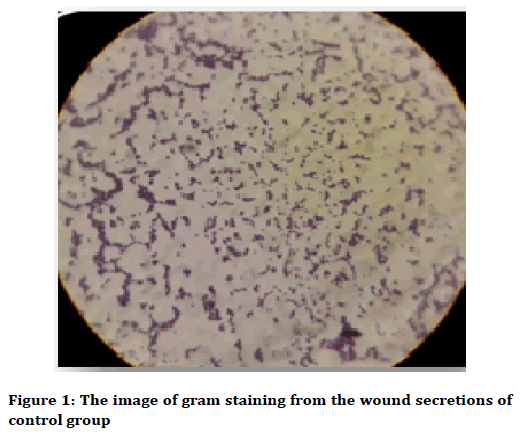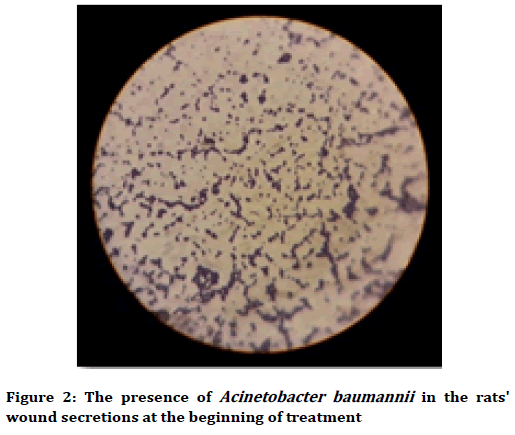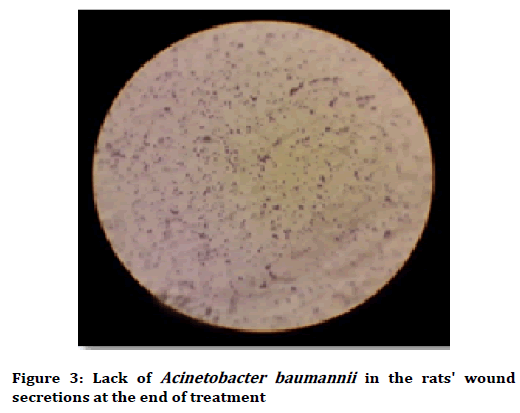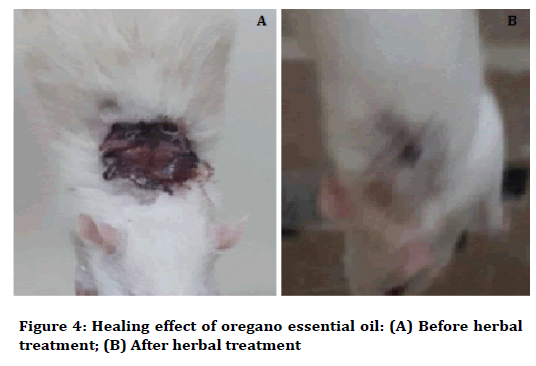Original Article - (2019) Volume 7, Issue 1
Growth Control of Acinetobacter baumannii in Infected Wound by Oregano Essential Oil in Rats
Mahmood Amini1,2, Ghasem Habibi1, Siamak Rakei2, Saeid Heidari2, Hanieh Taheri1, Rozita Baba Esfahani1, Maryam Sadrnia3, Marjan Salehi1 and Mohammad Arjomandzadegan1*
*Correspondence: Mohammad Arjomandzadegan, Infectious Diseases Research Center, Arak University of Medical Sciences, Iran, Email:
Abstract
Introduction: Acinetobacter baumannii known as a main agent in nosocomial infections and its drug resistance is a medical problem in hospitals. In the present study, growth control of Acinetobacter by Oregano essential oil was investigated in-vitro and in experimental wounds on rats.
Materials and Methods: Oregano essential oil (OES) was prepared by a Clevenger apparatus in a hydrodistillation process. Susceptibility of clinical isolate of Acinetobacterto essential oil was evaluated by disk diffusion and microbroth dilution methods. Ketamine and xylazine were used for surgical anesthesia induction in rats. The backs of 30 rats were shaved and an experimental wound in one square inch was prepared between two scapulae. All the ulcers were infected with fresh culture of Acinetobacter. The rats were divided into three equal groups for treatment by OES twice a day, treatment with silversulfuridine ointment (SSO) and control group without any treatment. Infection symptoms were assessed until the wound was fully granulated.
Results: MIC and MBC were as 4 mg/ml and 6 mg/ml, respectively. Blood culture of control group and SSO contained A. baumannii but was negative in treatment group. The cultivation and examination of the wounds and its secretions revealed the absence of A. baumannii in treatment group. Wound healing was faster in the treatment group than in the control groups.
Conclusion: Infection of the wounds infected with A. baumannii was interestingly controlled by OES and subsequently accelerated the wound healing process in Wistar rats. Therefore, OES recommends for evaluation in a clinical trial.
Keywords
Infected wound, Acinetobacter baumannii, Oregano essential oil, Rat
Introduction
Acinetobacter baumannii causes a wide range of infections, including urinary tract infections, meningitis, bacteremia, wound infections, skin and soft tissue infections, and respiratory infections, especially in hospital care units [1-4].
This bacterium is highly resistant to antimicrobial agents, and this resistance can be inherent or acquisitive. This bacterium has the ability to acquired resistance to various antibiotic classes, resulting in its multi-drug resistance. Today, A. baumannii shows resistance to most antibiotics including aminoglycosides, carbapenems, cephalosporins and beta-lactams [3,5,6]. Multidrug-resistant (MDR) A. baumannii was detected in many hospitals on immunosuppressed patients [7]. Therefore, it is necessary to work on the antibacterial activity of traditional medicinal plants.
The use of plant compounds to control infections by this bacterium has attracted the attention of many researchers. Oregano is rich in essential oils with the main components of alpha thujene, alpha-pinene, octanone, terpinene, p cymene, carvacrol and thymol. These compounds have antioxidant, anti-microbial, and antiproliferative properties in tumor cells, antithrombin and antihyperglycemia. Studies have been shown that this plant is useful in the treatment of cancer, heart disease and hypertension [8,9].
High antimicrobial capacity of Oregano essential oil have been proven against a wide range of bacteria including different species of Staphylococcus, Pseudomonas, Bacillus and Escherichia coli, as well as some fungal species such as Aspergillus, Fusarium and Penicillium [10].
A wound that does not heal after 48 hours is likely to be infected. The wound infection rate in clean and uncontaminated wounds is about 14% but contamination by drug resistant strains (e.g. A. baumannii) is occurred as a nosocomial infection in some hospitals [1,2,11].
We hypothesized that the Oregano Essential Oil has anti- A. baumannii effect. The purpose of this study was to Acinetobacter control in-vitro and in experimental wounds in Wistar rats.
Materials and Methods
Bacterial strain
Clinical isolate of Acinetobacter baumannii strain was obtained from the microbial bank of the Infectious Disease Research Center of Arak University of Medical Sciences, Arak, Iran.
Disc diffusion
The susceptibility of bacteria to Oregano essential oil was investigated. Fresh bacterial suspension in a concentration of 1.5 × 108 CFU/ml was spread over a Mueller Hinton Agar medium surface. Blank disks were placed on the medium loaded with 20 μL of diluted Oregano essential oil in various concentrations. The plates were placed in a 37°C incubator for 24 hours and the diameter of the zone of inhibition was measured at the end of the incubation period.
Microplate dilution method
In order to determine the minimum inhibitory concentration (MIC), fresh culture of the isolate was added to 100 μl of the prepared suspension in each of the 96-well plates. Then 100 μl of diluted essential oil was added to the first well and repeated to well number 9 and finally discarded 100 μl of the solution. In tenth well the bacteria suspension was poured as positive control. After 18-20 hours of incubation, the turbidity was measured using a spectrophotometer at a wavelength of 550 nm.
Preparation of the plant and essential oil
The Oregano plant was washed twice and dried in a dark room in a 23°C ± 2°C. Afterwards, the dried plant was powdered by a chopper. 40 g of powdered plant plus 400 L water were placed into a glass balloon of a Clevenger and the essential oil was extracted using the heater.
Animal study
Thirty rats were exposed to general anesthesia with ketamine and Xylazil and then their backs' hairs were shaved. 2.5 cm2 wound was created between the rats' shoulders with a special surgical instrument.
Wound infection
Fresh Acinetobacter suspension was inoculated using insulin syringes directly into the newly created wounds in all rats. Infection of the wounds was assessed by microscopic examinations and microbial culture in the Mueller Hinton Agar culture medium after 24 h and 48 h.
Study groups
Wounded rats were divided into three groups of 10 rats. The treatment group was considered to be treated with essential oil, the control group with 1% Silver Sulfadiazine ointment, and the third group was without treatment and considered as control. The debridement process and the clinical signs of infection were examined until the wound was fully granulated.
Essential oil was sprayed on the wound with insulin syringe twice a day. This process continued until the end of the treatment period. The dose and volume of drug was determined following the microplate dilution test results.
Results
Acinetobacter baumannii was isolated from the blood culture of the control group and was sub-cultured into the Mueller Hinton Agar medium but any were separated from the blood culture of the treatment group.
Gram stain and culture of wound secretions revealed that gram-negative bacteria had grown on the culture medium and gram-negative bacterium had also grown in the culture of the wound, and the grown bacteria were identified as Acinetobacter baumannii (Figure 1).

Figure 1: The image of gram staining from the wound secretions of control group
Moreover, gram staining was prepared from wound secretions at the beginning and end of the treatment during the treatment period of the wounds, which confirmed the presence of a large community of Acinetobacter baumannii in the wounds at the start of treatment and the lack of this bacterium at the end of the treatment (Figure 2 and Figure 3).

Figure 2: The presence of Acinetobacter baumannii in the rats' wound secretions at the beginning of treatment

Figure 3: Lack of Acinetobacter baumannii in the rats' wound secretions at the end of treatment
In addition, the wound healing process that had been greatly improved by the effect of Oregano essential oil was proven (Figure 4).

Figure 4: Healing effect of oregano essential oil: (A) Before herbal treatment; (B) After herbal treatment
Discussion
One of the major concerns in the treatment of infections caused by antibiotic-resistant bacteria is the high cost and long duration of the treatment.
The results of this study showed that Oregano essential oil was useful for the treatment of infected wounds by Acinetobacter baumannii and also accelerates the wound healing process.
The healing process follows the natural trend of improvement in the case of acute wounds, while the healing process slows down or is disrupted in the case of chronic or non-healing wounds due to the involvement of an internal or external agent at one of the stages of recovery. Upon the creation of a wound, the body has to start and continue several responses simultaneously, including preventing the bleeding, preventing the attacks of bacteria and microorganisms, and removing the dead tissues and external objects from the wound site and producing new tissues in the wound.
The wound healing in the case of infected wounds is more complicated and depends on the amount of tissue damage and the type of infection. A simple accumulation of purulent substances inside the skin and subcutaneous tissue is treated through a surgical incision. If the wound infection happens to penetrate into the deeper parts of the skin or if there is a dangerous microbial agent that causes the subcutaneous tissue to be destroyed, it is necessary that a surgeon open the wound and remove the destroyed tissue and administer long-term antibiotics.
According to the previously conducted studies, Oregano essential oil can cure and shorten the healing duration of infectious wounds. Scandorieiro et al., from the University of Aichi Gakui conducted a study on the synergistic effect of Oregano essential oil and silver nanoparticles on several drug-resistant bacteria, including Acinetobacter baumannii bacteria; coming to the conclusion that essential oil in low concentration levels has bactericidal effect on all drug-resistant bacteria including Acinetobacter baumannii [12].
A study conducted in Iran by Pajohi et al. to evaluate chemical compounds and antimicrobial activity of oregano essential oils and cumin seed, and showed that Oregano essential oil has an appropriate antimicrobial effect [13].
The results of this study proved the effectiveness of Oregano essential oil without silver nanoparticles.
Several studies have dealt with the effects of other plants on Acinetobacter. One of these studies was conducted in Thailand by Phatthalung et al., who showed that the Thai herbal extracts such as black helium, when combined with Novobiocin, can positively affect Acinetobacter baumannii [14]. Another study was carried out by Sakkas et al. at Ioannina University of Greece on the antimicrobial activity of the essential oils of five plants on the Gram-negative drug-resistant bacteria, including Acinetobacter baumannii. This study showed that the essential oils of basil, marigold, tea tree and thyme can inhibit the growth of Acinetobacter baumannii, while chamomile has no antibacterial effect [15].
In the present study was proved the effect of Oregano essential oil on Acinetobacter.
Conclusion
The findings of this study indicate that Oregano essential oil can have significant antibacterial effects on Acinetobacter baumannii-infected wounds and subsequently accelerate the healing of infectious wounds in Wistar rats. Therefore, this plant is recommended for conducting clinical trials.
Acknowledgments
The authors would like to kindly thanks from deputy of Research Arak University of Medical Sciences.
Conflict of Interest
The authors declare that there is no conflict of interest regarding the publication of this manuscript.
References
- Peleg A, Seifert H, Paterson D. Acinetobacter baumannii: Emergence of a successful pathogen. CMR 2008; 21:538-82.
- Baumann P. Isolation of Acinetobacter from soil and water. J Bacteriol 1968; 96:39-42.
- Boroumand M, Akhyani H, Sheikhvatan M, et al. Evaluation of antimicrobial resistance of Acinetobacter baumannii to imipenem, ciporofloxacin and ceftazidime using e test. Iran J Public Health 2009; 38:130-3.
- Mak JK, Kim MJ, Pham J, et al. Antibiotic resistance determinants in nosocomial strains of multidrug-resistant Acinetobacter baumannii. J Antimicrob Chemother 2008; 63:47-54.
- Setareh M, Javaherdashti R. Assessment and control of MIC in a sugar cane factory. Mater Corros 2003; 54:259-63.
- Kahbazi M, Fahmizad A, Armin S, et al. Aetiology of upper respiratory tract infections in children in Arak city: A community based study. Acta Microbiol Immunol Hung 2011; 58:289-96.
- Zeana C, Larson E, Sahni J, et al. The epidemiology of multidrug-resistant Acinetobacter baumannii: Does the community represent a reservoir? Infect Control Hosp Epidemiol 2003; 24:275-9.
- Moradi M, Hassani A, Ehsani A, et al. Phytochemical and antibacterial properties of Origanum vulgare ssp. gracile growing wild in Kurdistan province of Iran. J Food Qual Hazards Control 2014; 1:120-4.
- Rezvani ME, Roohbakhsh A, Mosaddegh MH, et al. Anticonvulsant and depressant effects of aqueous extracts of Carum copticum seeds in male rats. Epilepsy Behav 2011; 22:220-5.
- Gulluce M, Sahin F, Sokmen M, et al. Antimicrobial and antioxidant properties of the essential oils and methanol extract from Mentha longifolia L. ssp. longifolia. Food Chem 2007; 103:1449-56.
- Ghasemikhah R, Mirhendi H, Kia E, et al. Morphological and morphometrical description of trichostrongylus species isolated from domestic ruminants in Khuzestan province, southwest Iran. Iran J Parasitol 2011; 6:82-8.
- Scandorieiro S, de Camargo LC, Lancheros CA, et al. Synergistic and additive effect of oregano essential oil and biological silver nanoparticles against multidrug-resistant bacterial strains. Front Microbiol 2016; 23:1-14.
- Pajohi AM, Tajik H, Akhondzadeh A, et al. A study on chemical composition and antimicrobial activity of essential oil of Mentha longifolia L. and Cuminum cyminum L. in soup. Iran J Food Sci Technol 2012; 9:33-45.
- Phatthalung PN, Chusri S, Voravuthikunchai SP. Thai ethnomedicinal plants as resistant modifying agents for combating Acinetobacter baumannii infections. BMC Complement Altern Med 2012; 12:1-8.
- Sakkas H, Gousia P, Economou V, et al. In vitro antimicrobial activity of five essential oils on multidrug resistant gram-negative clinical isolates. J Intercult Ethnopharmacol 2016; 5:1-9.
Author Info
Mahmood Amini1,2, Ghasem Habibi1, Siamak Rakei2, Saeid Heidari2, Hanieh Taheri1, Rozita Baba Esfahani1, Maryam Sadrnia3, Marjan Salehi1 and Mohammad Arjomandzadegan1*
1Infectious Diseases Research Center, Arak University of Medical Sciences, Arak, Iran2Department of Surgery, School of Medicine, Arak University of Medical Sciences, Arak, Iran
3Department of Biology, Payame Noor University, Iran
Citation: Mahmood Amini, Ghasem Habibi, Siamak Rakei, Saeid Heidari, Hanieh Taheri, Rozita Baba Esfahani, Maryam Sadrnia, Marjan Salehi, Mohammad Arjomandzadegan, Growth control of Acinetobacter baumannii in infected wound by oregano essential oil in rats, J Res Med Dent Sci, 2019, 7(1): 136-139
Received: 19-Dec-2018 Accepted: 07-Feb-2019
